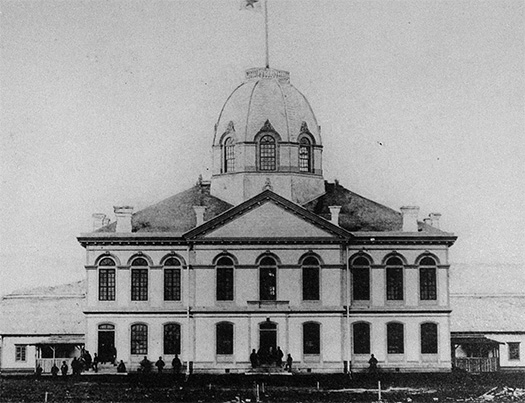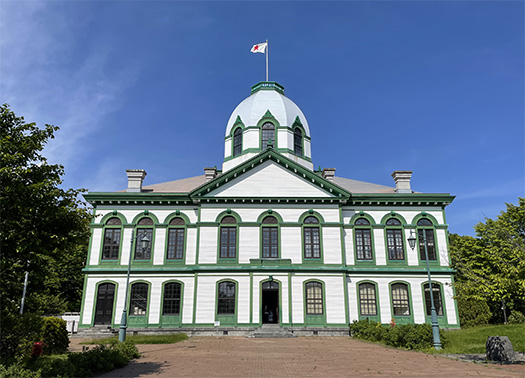

北海道草創期の古写真再発掘シリーズ。
現在の北海道庁赤煉瓦庁舎は、札幌の観光コースの定番と言える存在。実際上の実務部門がそこにあるワケではなくその後ろ側のコンクリート建築に機能は移転しているので、いわばランドマークとしての役割を担っている建物。
現代という時間の常識感覚には一種の「マヒ」効果があるだろうが、ちょっと時間感覚を明治6年・1873年、いまから151年前に遡らせて想像してみると、北海道札幌の開拓期にこの建築感覚が突如、出現した風景がみえてくる。
明治2年の箱館戦争の終結からわずか4年。北海道開拓の大号令が発せられ、北海道神宮の前身、札幌神社が明治天皇の「勅願」としての開拓三神を背負って判官・島義勇がこの地に来たのも明治2年なので、その大車輪ぶりがわかる。
そもそもこの開拓計画の基本構想を薩摩閥の巨魁・黒田清隆が渡米して、当時のアメリカ政府農務省局長・ケプロンに依頼してかれを高額報酬で招聘するのが明治4年。その基本構想は、実現されたものもそうでなかったものもあったとされるけれど、少なくともその建築としての象徴は、こうして現実化した。
まさに北海道での建築の基本は「洋造」であるべきだという大方針の明示。
薩摩藩の軍人トップである黒田清隆が、当時のアメリカの農政家、合衆国農務局長を無謀に口説き落としたというあたり、明治の「革命政権」ぶりが伝わってくる。
ケプロンは北海道における都市建設、大農場経営の採用,札幌農学校設立などの指導にあたり,北海道開発の基礎を確立した。
この竣工当時の建築はほどなくして明治12年に火災で焼失するので、その命はたったの6年間だけれど「開拓精神の鼓舞」というランドマークとしての役割は果たしただろうし、その後の北海道の中核建築としての政庁庁舎建築の規範となって、のちの赤煉瓦庁舎にまで、その精神性を伝えてきているのだと思う。
それまでの「城郭建築」に取って変わって、権力の意思というものの内実がこのように大きく革命された、そういう意味合いが強い。
いま、北海道開拓の村にこのように再生された建築が建てられているけれど、一種独特の清々しさをいまでも感じさせられる。
明治初年に於いてここまでアメリカと文化共有していたものが、どうしてその後、日米開戦にまで至ってしまったのか、歴史の不条理も感じさせられてしまう。
English version⬇
The “Western-style” Kaitakushi (Development Office) main office building that took the heart of the Meiji Restoration in the 6th year of the Meiji Restoration.
An easy-to-understand expression of the design concept for architecture adopted by the revolutionary government of the Meiji era. A major policy statement of architectural administration policy. Scenery of Meiji Nippon. …
A series of re-discovered old photographs from Hokkaido’s pioneer days.
The current red-brick building of the Hokkaido Government Office is a staple of Sapporo’s sightseeing courses. The building serves as a landmark, so to speak, since the actual business department is not located there, but its functions have been moved to the concrete building behind it.
Although there may be a kind of “paralysis” effect in the common sense of the present time, if we imagine back our sense of time to 1873 (Meiji 6), 151 years ago, we can see the landscape in which this architectural sense suddenly appeared in the pioneer days of Sapporo, Hokkaido.
It was only four years after the end of the Hakodate War in 1869. The great order for the development of Hokkaido was issued and the Sapporo Shrine, the predecessor of the Hokkaido Shrine, was built in the 2nd year of Meiji (1869), when the judge, Shima Yoshiyuu, came to this area with the three gods of development as the “imperial command” of the Emperor Meiji, which shows the great wheel he rode.
It was in the 4th year of Meiji that Kiyotaka Kuroda, the leader of the Satsuma clan, came to the U.S. and asked Kepron, then director of the U.S. Department of Agriculture, to invite him for a large sum of money to develop the basic concept of this pioneering plan. Some of his basic ideas were realized and some were not, but at least the architectural symbolism was realized in this way.
It is a clear statement of the major policy that the basis of architecture in Hokkaido should be “Western-style architecture.
The fact that Kiyotaka Kuroda, the top military officer of the Satsuma Clan, recklessly persuaded the then U.S. agricultural policy maker, the U.S. Secretary of Agriculture, to join him in this project shows the “revolutionary” nature of the Meiji era.
Kepron established the foundation for Hokkaido’s development by guiding the construction of cities in Hokkaido, the adoption of large-farm management, and the establishment of the Sapporo Agricultural College.
The building at the time of its completion was destroyed by fire in 1879, so although it lasted only six years, it probably fulfilled its role as a landmark that “inspired the spirit of pioneering,” and it has become a model for subsequent buildings of government offices as the core architecture of Hokkaido, even the red-brick government office building that was later built to transmit that spirit. I believe that this building has continued to transmit the same spirit to later red-brick government office buildings.
The building replaced the “castle architecture” of the past, and in this way, it has a strong sense of having revolutionized the inner workings of the will of power.
Nowadays, a building like this is being built in the Hokkaido pioneer village, and I still feel a kind of peculiar freshness.
It also makes me feel the absurdity of history, wondering how something that shared so much culture with the U.S. in the early Meiji period ended up in the outbreak of the war between Japan and the U.S.
Posted on 5月 25th, 2024 by 三木 奎吾
Filed under: 歴史探訪







コメントを投稿
「※誹謗中傷や、悪意のある書き込み、営利目的などのコメントを防ぐために、投稿された全てのコメントは一時的に保留されますのでご了承ください。」
You must be logged in to post a comment.